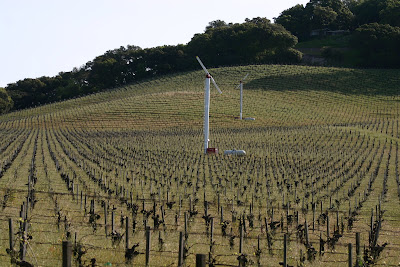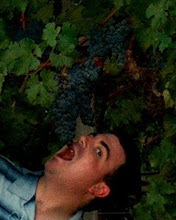I think it's time we talked about Sonoma County's wine growing regions.
First a map to help orientate yourself....

(Map courtesy of the Sonoma County Winegrape Commission)
Sonoma County is very unique. It is the only growing region in the world that has climates of very cool, cool, warm and very warm (some would say cold to hot) all within the confines of one AVA - American Viticulture Area. AVA's are controlled by the Alcohol and Tobacco Tax and Trade Bureau. Wineries can petition to create new boundaries, but it is a difficult process.
Temperature highs in these AVA's, during the growing season (April - October), can range upwards of 40 degrees in some cases. In addition temperature swings from overnight to the hottest part of the day can range 40-plus degrees as well. All great things when growing grapes.
I'll start tonight by covering the AVA's encompassed by Sonoma Valley. Sonoma Valley has three AVA's within its borders. These are areas that have significantly different temperatures and/or soils than the larger AVA.
Los Carneros (The Ram):Los Carneros, usually referred to as just "Carneros" spans both Sonoma and Napa Valley's. Sonoma's portion is cooler due to winds coming off the ocean and San Pablo bay. Soils are primarily clay and the top soil is not deep causing drainage problems. The Most common grapes in the region: Chardonnay, Pinot Noir, Syrah and small amounts of Pinot Blanc and Merlot. A majority of the grapes in this region are used for sparkling wine production.
Sonoma Valley:Cool on the southern end and warm on the northern end, Sonoma Valley (like Napa Valley) can have a wide range of temperatures. There is also a set of mountains that help with controlling wind and rain. The Mayacamas to the east and Sonoma Mountain to the west. As a result, there is valley floor fruit as well as hillside fruit. There is a significant difference between the two, with hillside grapes generally more stressed producing smaller berries and more concentrated flavors. Soils range from clay on the floor to volcanic in the mountains. It is an area where many types of grapes will grow including: Rhone and Bordeaux varieties, Italian and German among others like Zinfandel. There are nearly 40 different grapes growing in this one region. AVA's within Sonoma Valley: Los Carneros, Sonoma Mountain and Bennett Valley. Fun fact: The first grapes were planted in Sonoma Valley in 1824.
Sonoma Mountain:Sonoma Mountain AVA is small, but diverse. The terrain varies significantly throughout the area. There are little pockets where only certain grapes will grow. Sometimes fog will sit in pockets for hours longer than the surrounding areas. Up in the higher areas mostly Cabernet Sauvignon is grown, but the lower areas have grapes ranging from Chardonnay to Syrah, Grenache and Mourvedre. It is one of Sonoma County's smallest AVA's.
Bennett Valley:Sonoma County's newest AVA, Bennett Valley, is one of the area's coolest regions. With fog and wind influence from both the Pacific Ocean and San Pablo Bay, it consistantly runs 5-7 degrees cooler than neighboring Sonoma Valley. Although, on significantly foggy days this range can be upwards of 20 degrees. Soils range from clay to volcanic, much like Sonoma Valley. But Bennett Valley has a rock in the soil called basalt that can impart a smokey characteristic on the wines. Grapes grown in this area include Chardonnay, Merlot, Pinot Noir and small amounts of Granache and Syrah. Cool fact: Bennett Valley only has one winery open to the public daily.
That's all for tonight. Next time we'll tackle the regions of Russian River, Dry Creek and Alexander Valley.
Cheers!
 Seriously, don't even ask. Funny I didn't see that next to any of the Sonoma wines on the list.
Seriously, don't even ask. Funny I didn't see that next to any of the Sonoma wines on the list.





 It's an Italian Prosecco (sparkling wine) from Trader Joe's. This wine is a great start to an evening. There's just something about bubbles that makes it feel like a special occasion. And at less than $6, this wine can make almost any day a special occasion. It also makes great mimosas for that Sunday brunch.
It's an Italian Prosecco (sparkling wine) from Trader Joe's. This wine is a great start to an evening. There's just something about bubbles that makes it feel like a special occasion. And at less than $6, this wine can make almost any day a special occasion. It also makes great mimosas for that Sunday brunch. It was the first time I tried this Syrah from Sonoma Valley. I've had their Zin on several occasions.
It was the first time I tried this Syrah from Sonoma Valley. I've had their Zin on several occasions.  The fruit was plum and blackberry with hints of cooking spices and smoked meats. It was a perfect selection for the grilled tri-tip. I don't have many "rules" for wine, but when it comes to foods coming off the grill they are usually paired best with Syrah. There's just something about it. This wine was perfectly balaced and had one of the best mouthfeels I've ever experienced with a Syrah. I have to get some more of this before they run out!
The fruit was plum and blackberry with hints of cooking spices and smoked meats. It was a perfect selection for the grilled tri-tip. I don't have many "rules" for wine, but when it comes to foods coming off the grill they are usually paired best with Syrah. There's just something about it. This wine was perfectly balaced and had one of the best mouthfeels I've ever experienced with a Syrah. I have to get some more of this before they run out! We also finished up with a Lemon Meringue pie that my mother-in-law baked with fresh lemons from her garden. Sorry for no picture, but we gobbled it up so fast, there wasn't a chance....it was spectacular.
We also finished up with a Lemon Meringue pie that my mother-in-law baked with fresh lemons from her garden. Sorry for no picture, but we gobbled it up so fast, there wasn't a chance....it was spectacular.

 Isn't she cute? They do a pig roast every year (because their wines go so well with pork), but I was informed that Ruby is here to stay. Good news, because my kids would be disappointed if we showed up and she wasn't there.
Isn't she cute? They do a pig roast every year (because their wines go so well with pork), but I was informed that Ruby is here to stay. Good news, because my kids would be disappointed if we showed up and she wasn't there.


 Some growers use a sprinkler system that coats the grapes with water which then freezes. It sounds counter-intuitive, but the frozen water around the grapes actually keeps the grapes from freezing.
Some growers use a sprinkler system that coats the grapes with water which then freezes. It sounds counter-intuitive, but the frozen water around the grapes actually keeps the grapes from freezing. This vineyard, and many others I drove past, haven't been pruned. It's not uncommon for growers to wait until early March to prune. This can protect them for an additional 7-14 days from frost by delaying bud-break. However, this late in the game, the reality is that this vineyard likely isn't being pruned because it has fallen out of contract. In other words, the growers don't have anyone to sell their grapes to. Bummer.
This vineyard, and many others I drove past, haven't been pruned. It's not uncommon for growers to wait until early March to prune. This can protect them for an additional 7-14 days from frost by delaying bud-break. However, this late in the game, the reality is that this vineyard likely isn't being pruned because it has fallen out of contract. In other words, the growers don't have anyone to sell their grapes to. Bummer.




 The wine has aromas of blackberry and cherry with a bouquet of white pepper and clove. The difference between an aroma and a bouquet? Aromas are generally characteristics that are associated with a young wine and a bouquet will develop with time in the bottle.
The wine has aromas of blackberry and cherry with a bouquet of white pepper and clove. The difference between an aroma and a bouquet? Aromas are generally characteristics that are associated with a young wine and a bouquet will develop with time in the bottle.



 I bought this a couple of years ago and managed to put it away in my cellar and forget about it. It has developed beautifully. The nose was packed full of aromas like blackberry, plums, black pepper and little hints of smoke, redwood bark and barnyard - all pleasing smells. In the mouth, the wine is velvety, packed full of flavors and has an extremely long finish.
I bought this a couple of years ago and managed to put it away in my cellar and forget about it. It has developed beautifully. The nose was packed full of aromas like blackberry, plums, black pepper and little hints of smoke, redwood bark and barnyard - all pleasing smells. In the mouth, the wine is velvety, packed full of flavors and has an extremely long finish.



 Usually, we go to Murphy's Irish Pub in Sonoma because, after all it's in our own town. But on this particular night we made the trip to downtown Santa Rosa to visit Stout Brothers.
Usually, we go to Murphy's Irish Pub in Sonoma because, after all it's in our own town. But on this particular night we made the trip to downtown Santa Rosa to visit Stout Brothers. Along with the Guinness, I tried a Bushmills 1608. Usually, I drink Jameson Irish Whiskey, but on this night I wanted to try something new. This Bushmills was outstanding. Sure, it was pricey, but aren't most things of high quality?
Along with the Guinness, I tried a Bushmills 1608. Usually, I drink Jameson Irish Whiskey, but on this night I wanted to try something new. This Bushmills was outstanding. Sure, it was pricey, but aren't most things of high quality?
